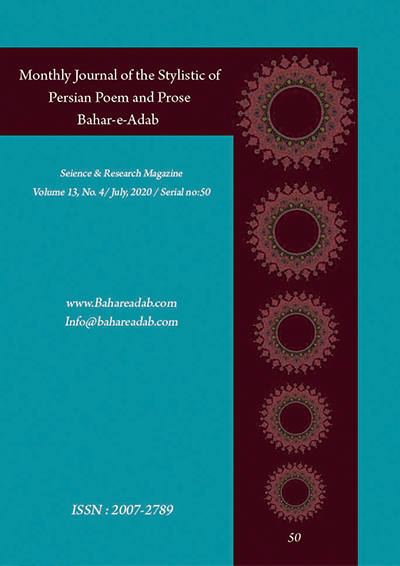- Count View : 542
- آدرس کوتاه شده مقاله: https://bahareadab.com/article_id/365
Journal of the stylistic of Persian poem and prose
volume Number 13،
number In Volume 4،
،
issue Number 50
An Investigation of Rhetorical Functions in Rumi's Sonnets
Zahra Irani, Malek Mohammad Farokhzad(Author in Charge), Reza Heydari Nouri
Abstract
One of the approaches in "Apostrophe" is to employ direct statements in conveying meanings. The advantages of the direst statement are as follows: affecting the audience more, better conveying the supposed meaning and making the audience mentally prepared for the desired meaning. Among mystical poems, Rumi"s have a special impact on the audience. This worthy attribute is intensified by his penetrating language and occasionally by the mysterious silence he imposes in his poems. His silence does not derive from his incapability and helplessness; rather, it is a medium to convey a more transcendental meaning. Based on the structuralism of Jacobson and Ephrat concerning the communicative function of words between the speaker and the addressee, a meaning is conveyed through a physical channel. This theory is proposed in the six following forms: provoking, meta-lingual, emotional, empathetic, literary and referential. In this study, these factors are applied to analyze the silence and its examples in Rumi"s sonnets.
Keyword
Jacobson
, Ephrat
, Rumi
, Sham's Sonnets
, Rhetorical silence
- Anousheh, Hassan (2002), Persian Literary Dictionary, Tehran. Ministry of Culture and Guidance
- Bruno, T., J. (1973), Silence from the Perspective of Linguistic Function, translated by Khosrow Bagheri, Tehran, Madrese
- Pournamdarian, Taghi (1997), Mysteries and Mysterious Stories in Persian Literature, Tehran, Elmi va Farhangi
- Zarrinkoob, Abdolhossein (2000), with Hilla Caravan, Tehran; Almi
- Saussure, Ferdinando (1983), General Linguistics Course, translated by Cyrus Safavi, Tehran. Hermes
- Seyed Hosseini, Reza (1997), Literary Schools, Tehran, Negah
- Shafiee Kadkani, Mohammad Reza (1989), Poetry Music, Tehran, Agah
- ………, …….. (2008), Imagination in Persian Poetry, Tehran, Agah
- Shamisa, Sirus (2000), Witness play in Persian literature, Tehran, Ferdows
- …….., …….. (2005), Prose Stylistics, Tehran, Mitra
- Fatemi, Seyed Hossein (1985), Illustration in Ghazaliyat Shams, Tehran Amirkabir
- Forouzanfar, Badi-ol-Zaman (2005), Rumi's biography, Tehran, Tirgan
- Farhangi, Ali Akbar (1996), Non-Verbal Communication, Meybod, Islamic Azad University
- Mushtaq Mehr, Rahman (2013), Dictionary of Rumi's Ghazals, Tehran, Book House
- Rumi, Jalaluddin Mohammad (2007), Generalities of Shams Tabrizi Divan, Tehran, Pazhohesh
- Jacobsen, Roman (1997), Fundamental Trends in Language Knowledge, translated by Cyrus Safavi, Tehran, Hermes
- Rahimi, F (2013), A Study of the Role of Signs and Symbols of Words in Rumi's Poetic Language with the Approach of Shtak Sign, Journal of Islamic Mysticism, No. 35, p. 18
- Reza Doust, A. (2015), Contradictory view of Rumi's late orator and its hermeneutic effect on creative multiplicity, Journal of Literary Studies, No. 32, p,73
- Salehi Mazandarani, M., The Nature of Poetry as Narrated by Poets, PhD Thesis, Ahvaz, Chamran University, 2002

